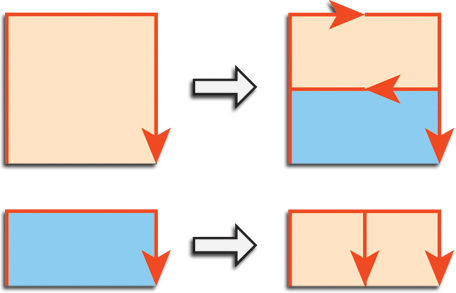I generated the following image in a non-ad hoc manner, with re-useable software that I developed myself.

That year after college I was kind of shiftless. I chose to just not participate in the whole interview circus that normally accompanies one's senior year of MIT and let myself graduate without having plans of any kind for the future. I think that I was tired mostly and was kind of sick of the universe of engineering and all of its hurdles and dog and pony shows, and I think I kind of half-understood that this would be the last time in my life in which it would be possible for me to be totally free of that universe -- until, I guess, retirement.
Anyway, I lived in the slums of Boston -- that is, Roxbury -- with a friend of mine from high school and some roommates we found, one of whom ended going to jail (but that is another story), worked temp jobs, and didn't do much of anything ... except for some reason I became obsessed with aperiodic tilings of the plane and substitution tilings generally and put a lot of effort into coming up with one of my own. I wanted to find, for reasons that aren't clear to me now, an aperiodic analog of the normal regular hexagon tiling.
It's kind of a blur -- I don't really remember where the above came from as a sequence of steps -- but the above is a patch of the best tiling I discovered during this period. It is generated via the following substitutions. The lengths of the sides of triangles and trapezoids are multiples of ?, the golden ratio.

As far as I know, the above is original and has not been discussed in the literature but I never was able to come up with local matching rules on the hexagons to enforce aperiodicity.
At that time I did develop software for working on these sorts of structures but what I came up with in retrospect wasn't The Right Thing. This wasn't all together my fault. Those were different times: no GitHub, no free code. If I wanted to output into a vector format it would have to be my own vector format. If I wanted to render that format to the screen I would have to write code to render that vector format to the screen, and so on. Also GUI applications were all the rage and were still new and shiny, so I was biased in that direction. I never really liked what I came up with then, and it wasn't portable anyway; it was a black-and-white Macintosh application in C.
Having the negative example of that project all those years ago made it easy to see what I actually needed: not a GUI application but a programming language. So last week, I wrote one: a little language for specifying recursive structures like the above and rendering them in SVG. I'm calling it Snurtle because it is basically a combination of Python (a snake) and the turtle-based graphics of Logo. I chose Python syntax because I wrote the Snurtle interpreter in Python and thus got tokenization for free using Python's "tokenize" module.
So, for example, the following simple substitution

is represented by the following Snurtle script:
sub square(n): terminal: poly("bisque", "orangered", 1 ): forward(n) turn(PI/2) forward(n) turn(PI/2) forward(n) nonterminal: rectangle(n) branch: turn(PI) forward(n/2) turn(-PI/2) forward(n/2) square(n/2) square(n/2)sub rectangle(n): terminal: poly("lightskyblue", "orangered", 1 ): forward(n/2) turn(PI/2) forward(n) turn(PI/2) forward(n/2) nonterminal: square(n/2) turn(PI) square(n/2)yielding

which, I think, is self-explanatory except for the "branch" block. Branch blocks tell Snurtle to push the state of the turtle on to a stack and then pop it when exiting the branch i.e. branch works like parentheses operators in L-systems. Also the following Snurtle constructs are not illustrated in the above:
- flip blocks: similar in syntax to branch above. Tell Snurtle to multiply the angle arguments passed to turn statements by -1. (i.e. flipping them)
- stroke and fill blocks: similar to "poly" above.
Anyway, here is my snurtle source code. Usage to generate the above would be:[quote]
snurtle.py -w -s square -k 500 -m 8 -o squares.html -c "10,10? "snurtle_scriptssquares.snu[/quote]
where- -w : wrap the generated SVG in HTML (so it can be viewed in browser)
- -s : initital substitution used to kick off the recursion
- -k : scale factor in SVG output
- -m : max stack depth before substituting in terminal blocks rather than nonterminal and ending the recursion
- -o : output filename
- -c : starting coordinate when generating SVG. (There is also a -d which similarly specifies the width and height attributes of the SVG but I am using the default in the above
Snurtle is pretty rough at this point, so check back here for updates if you are interested; in particular, substitutions can't currently have more than one argument and I want to make the color, etc., parameters to poly block be optional and maybe allow the user to specify z-order.
Source
- -w : wrap the generated SVG in HTML (so it can be viewed in browser)


That's really cool! And glad to hear you made it out of Roxbury alive :D